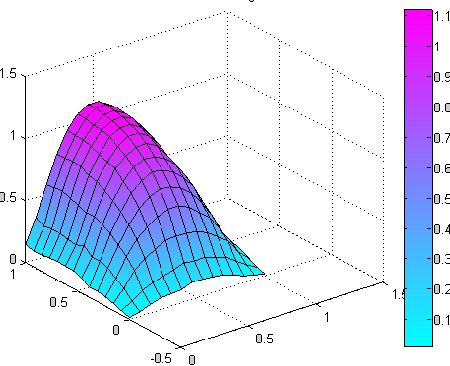The chapter theme results at the crossroads of some major scientific and technical domains: modern intelligent wireless sensor networks, distributed parameter systems, multivariable linear and non-linear estimation techniques, especially using artificial intelligence tools and virtual instrumentation (Tubaishat & Madria, 2003), (Giannakis, 2008), (Kubrulsky & de S. Vincente, 1977), (Volosencu, 2008). And, an important application is fault detection and diagnosis in system monitoring (Chiang et. al., 2001). This modern concept involving may be represented in Fig. 1.

The domain of system identification may be developed today using the powerful tool represented by the intelligent sensor networks, placed in real distributed parameter systems. Wireless sensor networks (Akyildiz, F. et. al, 2002) may be seen as a collection of numerous sensor nodes, each with sensing (temperature, humidity, sound level, light intensity, magnetism, acceleration etc.) and wireless communication capabilities, providing huge opportunities for monitoring and mathematical modeling of the time-evolution of the physical quantities under investigation. Sensor networks have proved their huge viability in the real world in the last years (Feng et. al. 2002). One of the important problem related to the usage of wireless sensor networks in harsh environments is the identification of the states of the physical variables in the field, based on the measurements provided by the sensors (Novak & Mira, 2003), (Pottie & Kaiser, 2000), (Tong et. al., 2003), (Zhang et al.,2005).The modern intelligent sensor networks, with hundred and thousands of ad-hoc tiny sensor nodes spread across a geographical area, may be seen as a “distributed sensor, which may be placed in the field of the distributed parameter systems. The sensor network, as a “distributed sensor”, allows the usage of multivariable estimation techniques, in different ways: classical linear methods of modeling or methods based on artificial intelligence for complex non-linear systems. As smart and small devices the modern sensors are capable to be implemented in large distributed parameter systems.
As an example of distributed parameter system with large application in practice the process of heat conduction is presented. Other applications are presented in literature (Rosculet & Craiu, 1979), (Basmadjian, 1999).
The identification techniques (Ucinski, 2004), (Banks & Kunish, 1989), (Sjoberg, et. al., 1997), (Zhu et. al., 2007) are useful for applications ranging from control systems, fault detection and diagnosis, signal processing to time-series analysis. The artificial intelligence tools (Chairez et al., 2009), (Jassar et. al., 2009) may be used for identification of nonlinear complex systems as the distributed parameter systems are. ANFIS (Roger Jang, 1993), (Depari et. al., 2005), (Hou & Li, 2006), (Mellit et. al., 2007) as a method for non-linear system identification is a powerful tool to estimate future behavior in distributed parameter systems from acquired data obtained using wireless sensor connected in a distributed network placed in the field.The chapter presents a short survey of some results obtained in the study of using of sensor networks with multivariable estimation techniques for distributed parameter system identification. Sensor network topics, sensor network architectures and sensor network applications are presented. Starting from the measurements collected by the sensor nodes inside an investigated distributed parameter systems, this chapter offers an efficient methodology for identification with linear and non-linear time series. Some estimation algorithms and a method for monitoring distributed parameter systems based on sensor networks and the adaptive-network-based fuzzy inference scheme are presented (Volosencu, 2010). The chapter presents an application of a multivariable auto-regression estimation technique for estimation of heat transfer in space. A case study of temperature flow for a parabolic equation is analysed, based on these approach. Limited resources in terms of computational power, energy, memory and bandwidth impose heavy constraints on functionality of an effective malfunction detection system. For this reason these algorithms are designed and suitable for execution on the base station level and, by this, it is appropriate even for large-scale sensor networks. Sensor networks have proved their huge viability in the real world, being just a matter of time until this kind of networks will be standardized and used broadly in the field.
Sensor networks
Wireless sensor networks are extremely distributed systems having a large number of independent and interconnected sensor nodes, with limited computational and communicative potential. The sensors are deployed for data acquisition purposes on a wide range of locations, sometimes in resource-limited and hostile environments such as disaster areas, seismic zones, ecological contamination sites and other. In this structure data processing is at the sensor level, data transmission is wireless, sensing mechanism is not necessarily power supply is not necessarily wireless .Sensor network applications include:
environmental monitoring, civil infrastructure monitoring, shared resource utilization, tracking, perimeter protection and surveillance. Application are in micro-climates, air quality, soil moisture, animal tracking, energy usage,
office comfort, wireless thermostats, wireless light switches. In techniques they have as applications data acquisition of physical and chemical properties, at various spatial and temporal scales, as in distributed parameter systems, for automatic identification, measurements over long period of time. The sensor networks are deployed for data acquisition purposes on a wide range of locations, in resource-limited and hostile environments such as disaster areas, seismic zones, ecological contamination sites. All applications are distributed parameter systems.
The modern sensors are smart, small, lightweight and portable devices, with a communication infrastructure intended to monitor and record specific parameters like temperature, humidity, pressure, wind direction and speed, illumination intensity, vibration intensity, sound intensity, power-line voltage, chemical concentrations and pollutant levels at diverse locations. The sensor number in a network is over hundreds or thousands of ad hoc tiny sensor nodes spread across different area. Thus, the network actively participates in creating a smart environment. They are low cost and low energy devices, realized in nanotechnology. With them we may developed low cost wireless platforms, including integrated radio and microprocessors. The sensors are adequate for autonomous operation in highly dynamic environments as distributed parameter systems. We may add sensors when they fail. They require distributed computation and communication protocols. They assure scalability, where the quality can be traded for system lifetime. They assure Internet connections via satellite. The structure of a modern sensor (Akyildiz, F. et. al, 2002), (Pottie& Kaiser, 2000), (Tubaishat & Madria, 2003) is presented in Fig. 2.

The dimension of such a sensor is comparable with a small coin. The sensors are characterized by: a robust radio technology, cheap and energy efficient processors, lifetime energy source, on-board memory, flexible I/O for various sensors, common highly available components, efficient resource utilization – currently uses 10 µA average, high modularity, flexible open source platform. Some examples of technical data are: 128 KB instruction EEPROM, 4 KB data EEPROM, 512 KB External Flash Memory, radio with 38 K or 19 K baud, at 900MHz, LEDs, µP at 7,3 MHz, JTAG, programming board, ISM Bands: 433-434,8 MHz Europe, power consumption: 16 mA Tx, 9 mA Rx, 2 µA sleep, transmission range: 1m, off the floor 100m range, ground level 10 m range, interface block data to laptop, GPS, cost: $ 95.Sensor are developed to measure: temperature, humidity, pressure, wind direction and speed, illumination intensity, vibration intensity, sound intensity, acceleration, power-line voltage, chemical concentrations and pollutant levels at diverse locations and others. All are variables in distributed parameter systems. Hundreds or thousands of ad-hoc tiny sensor nodes spread across a geographical area form the basis of a sensor network. Sensor nodes collaborate among themselves to establish a sensing network. The sensor network provides access to information anytime, anywhere, by collecting, processing, analyzing and disseminating data. The network actively participates in creating a smart environment. Sensor network is working as a distributed sensor.
The constructive and functional representation of a sensor network is presented in Fig. 3 (Akyildiz, F. et. al, 2002), (Pottie & Kaiser, 2000), (Tubaishat & Madria, 2003).

The sensor networks have different structures. The star networks (point-to-point), are networks in which all sensors are transmitting directly with a central data collection point. The mesh networks are networks in which sensors can communicate with each other. In mesh networks sensor nodes can relay messages from other sensor nodes, there is no need for repeaters. Software controls the flow of messages through network with self- configuration. New nodes automatically detected and incorporate. Advantages of the mesh structures are: robustness, easily deployed, no RF site surveys needed, no repeaters needed, easily expanded.In the field of sensors networks some topics are involved, like: development topics: deployment, localization, synchronization, calibration; wireless communication: wireless radio, characteristics, MAC protocols, link layer techniques, power control; sensor network architecture; networking topics: topology control, data gathering, network monitoring, network coding; data-centric: routing and aggregation, querying and data basis, storage; hardware; software; security. Standards and protocols are imposed for sensor networks development. Different structure may be uses in practice, for example. The sensor network may be static or mobile. For a static case each sensor node knows its own location, even if they were deployed via aerial scattering or by physical installation. If not, the nodes can obtain their own location through the location process. Moreover, all the sensors passed a one-time authentication procedure done just after their deployment in the field. The sensor nodes are similar in their computational and communication capabilities and power resources to the current generation sensor nodes. Every node has space for storing up to hundreds of bytes of keying materials in order to secure the transfer of information through symmetric cryptography. There is a base station into the network, sometimes called access point, acting as a controller and also as a key server. It is assumed to be a laptop class device and it is supplied with long-lasting power. An example of a wireless cellular network architecture is presented in Fig. 4.


This structure used for large-scale sensor networks. The main difference related to the cellular network architecture is that base stations are considered to be mobile, so each cell has varying boundaries which implies that mobile wireless nodes and other appliances can communicate wirelessly, as long as they are at least within the area covered by the range of the mobile access point. Multiple sensor nodes can detect an event situated in the surrounding area, so redundancy of sensor networks is assured. In the next paragraph we presents some examples of such distribute parameter systems with their mathematical models with partial derivative equations.The space model of the sensor deployed in the field with the heat sources is presented inFig. 6.





Distributed parameter systems
The distributed parameter systems, opposed to the lumped parameter systems, are systems whose state space is infinite dimensional. An object whose state is heterogeneous has distributed parameters. Such a system is described by partial differential equations. Partial differential equations are used to formulate problems involving functions of several variables, such as the propagation of sound or heat, electrostatics, electrodynamics, fluid, flow, elasticity. Distinct physical phenomena have identical mathematical formulations, and the same underlying dynamic governs them. One of the most important domain of applications of the partial differential equations is the process of heat conduction, with propagation of heat in anisotropic medium: propagation of heat in a porous medium, transference of heat in semi-space compound by two materials submitted to heating, processes of transference of heat between a solid wall and a flow of hot gas, estimation of the temperature field in space with fissured zone having the form of a circular disc. Applications related to electricity domain are: the propagation of electric current in cables, the heating of the electrical contacts. In the field of motion of fluid there are: plane motion of viscous fluids, running of viscous fluids in rectilinear tube, computation of losses of non- stationary heat in subterranean pipe, running of gases in water main. The processes of cooling and drying: cooling of clap, cooling of a sphere, drying of wood pieces, drying in vacuum. Phenomenon of diffusion: diffusion flow in a heavy sphere for chemical reactions happening with finite spit on the sphere surface, the flames diffusion, which appears to the beginning of a tube, repartition density of particles loading by the meteorites. Other applications are: estimation of the ice height covering the snow the arctic seas, motion of underground waters, alloy of heavy fusible particles, investigation of the wave close to the single point of the board of a plane plate, the growing of the gas particles in a fluid, substances combustion, the temperature modification in the air mass. (Rosculet & Craiu,1979), (Basmadjian, 1999).
Processofheatconduction
Let it be an object of a volume V ⊂R3 . The frontier of dominium V is a surface S, formed by a finite number of smooth surfaces.
Let it be θ(P, t) the function of the object’s temperature, at the time moment t, where P∈V is a point in the volume V. If different points of object have different temperatures, θ(P, t)≠ct., then a heat transfer will take place, from the warmer parts to the less warm parts. Let it be a regular surface σ placed in V, which contains the point P. From the theory of thermal conductivity through the dσ in the time dt a heat quantity dQ is passing, proportional to the product dσ.dt and proportion to the function θ(P,t) derivative, along the normal n to the surface σ in the point P:












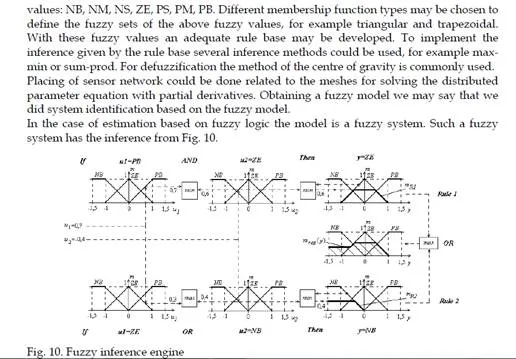
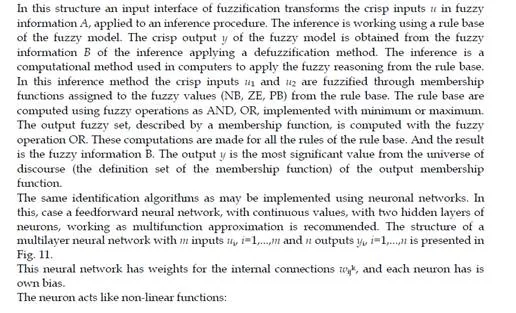
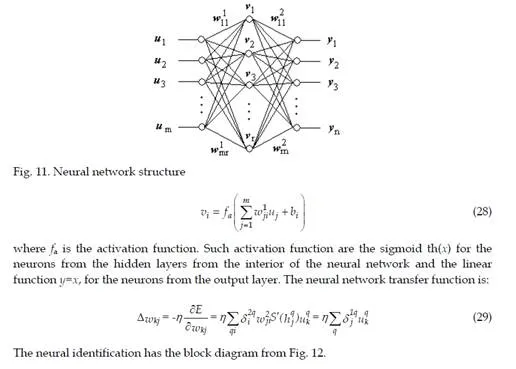

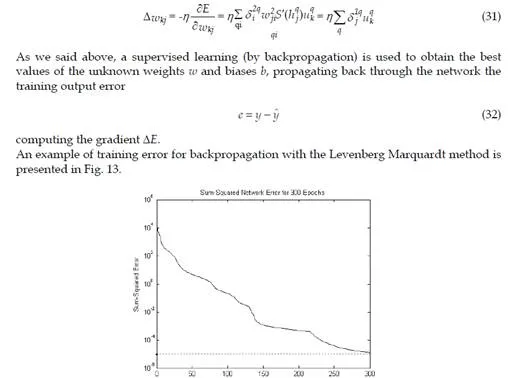
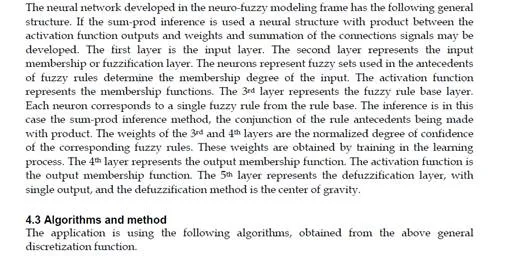
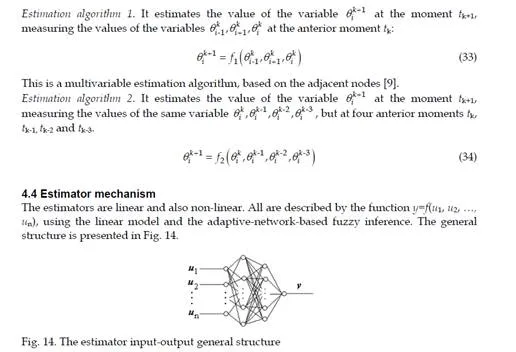
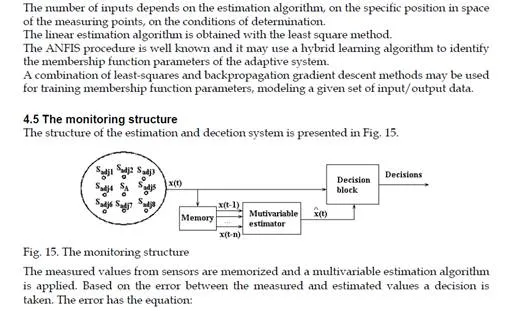

Method for monitoring
The following method is according to the objectives of monitoring of defined distributed parameter system from the practical application in the real world, as heat distribution, wave propagation. These systems have known mathematical model as a partial differential equation as a primary model from physics, with well-defined boundary and initial conditions for the system in practice. These represent the basic knowledge for a reference model from real data observation. The primary physical model must be discretized, to obtain a mathematical model as a multi input – multi output state space model. The unstructured meshes may be generated. The sensors must be placed in the field according to the meshes structured under the form of nodes and triangles. A scenario for practical applications could be chosen and simulated. The simulation and the practical measurements are producing transient regime characteristics. Those transient characteristics are due to the system dynamics in a training process. In steady state we cannot train the neural model. On these transient characteristics, seen as times series, the estimation algorithms may be applied. ANFIS is used to implement the non-linear estimation algorithms. With these algorithms future states of the process may be estimated. Possible fault in the system are chosen and strategies for detection may be developed, to identify and to diagnose them, base on the state estimation. In practice applying the method presumes the following steps: – placing a sensor network in the field of the distributed parameter system; -acquiring data, in time, from the sensor nodes, for the system variables; -using measured data to determine an estimation model based on ANFIS; -using measured data to estimate the future values of the system variables; -imposing an error threshold for the system variables; -comparing the measured data with the estimated values; -if the determined error is greater then the threshold a default occurs; -diagnosing the default, based on estimated data, determining its place in the sensor network and in the distribute parameter system field.
The interpolation techniques may be used for spatial distributed system identification with wireless sensor networks (Volosencu & Curiac, 2009).Considering the continuous development of the wireless device technology, securing wireless sensor networks became more and more a significant task. One of the important problems that are related to the use of wireless sensor networks in harsh environments is the gap in their security. The strategy on time series predictors based on past and present values obtained from neighboring nodes from this chapter with its estimation algorithms is a basic for discovery of malfunctioning or attacked sensor nodes. Some strategies based on antecedent values provided by each sensor are presented for detecting their malicious activity in (Curiac et. al., 2007), (Curiac et. al., 2009), (Plastoi et. al., 2009).
Experimental results
In this chapter a parabolic case study consisting in a heat distribution flux through a plane square surface of dimensions l=1, with Dirichlet boundary conditions as constant temperature on three margins:
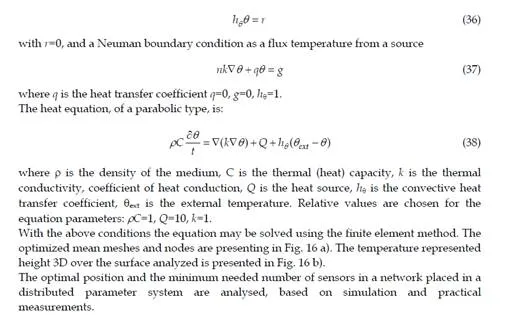
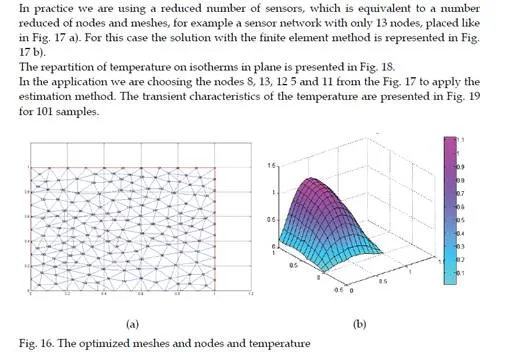
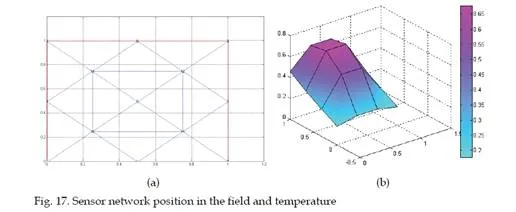
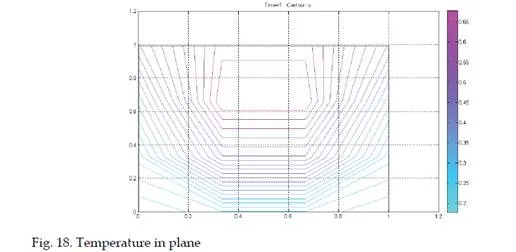
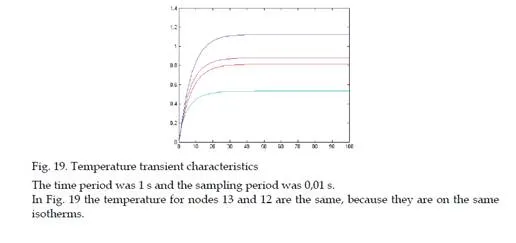
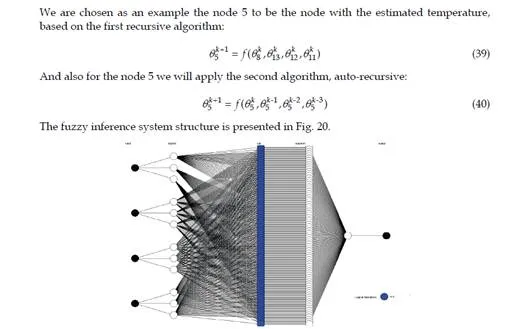
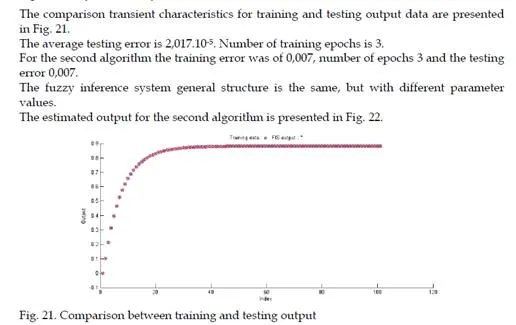
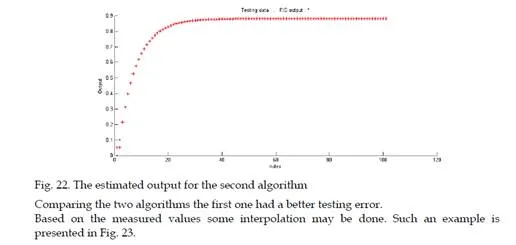
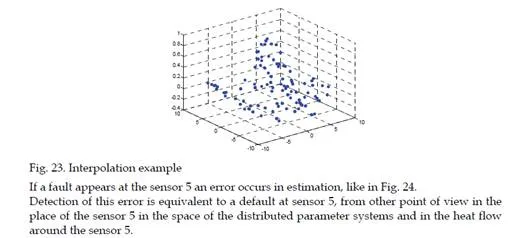
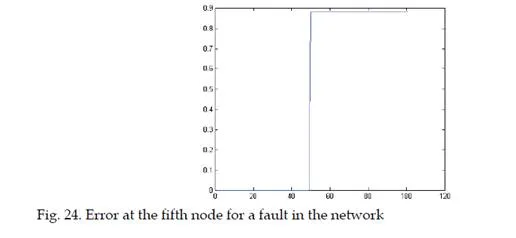
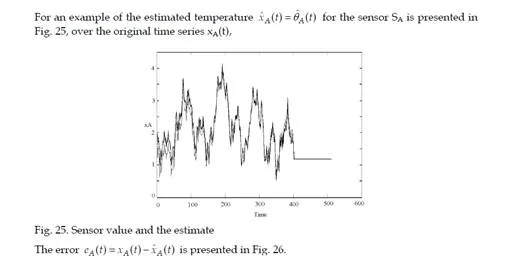
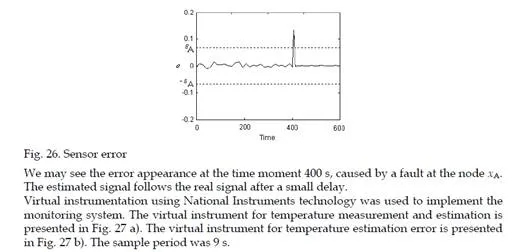


Conclusion
This chapter presents some considerations on time series identification methodology using a wireless sensor network as a complex measurement system. After acquiring the measured values from the area covered by sensor networks, some estimation techniques may be applied. Some auto-regression estimation linear or ANFIS models may be developed. This methodology can be efficiently implemented on sensor network base stations, so there is no need for other hardware resources.A comparison of different identification methods is presented, in order to use the adaptive-network-based fuzzy inference. Some examples of generated meshes and temperature estimates for different numbers of sensor are presented. The main attention is given to the way of how to chose the number and the positions of the sensor nodes according to the desired accuracy in the identification process.The chapter presents two algorithms for estimation of state variables in distributed parameter systems of parabolic case. The algorithms are based on non-linear exogenous models with regression and auto-regression. Also, a method for monitoring distributed parameter systems based on these algorithms, sensor networks and ANFIS for non-linear system identification is presented.
The sensor network is seen as a “distributed sensor”. The algorithms are based on regression using the values provided by the adjacent nodes of the sensor network and on autoregressive relation with the values from anterior time moments of the same node.
The method described the way how to use all these concepts for fault detection and diagnosis in distributed parameter systems, using the measured values provided by the sensor and the estimated values computed by the ANFIS estimator, calculating an error and detecting the fault based on a decision taken after a threshold comparison. Estimations methods may be applied in the case of discovery of malicious nodes in wireless sensor networks.
A case study for two algorithms are presented for parabolic type. A comparison between the algorithms is made. Good approximations were obtained. Developing of the algorithms and the method are taken in consideration in the future, in other applications, considering all the capabilities of the sensor nodes to measure physical variables. This approach allows treatment of large and complex systems with many variables by learning and extrapolation. An interesting application could be the monitoring of earth environment at low and high altitudes, based on new types of sensor networks specialized for this purpose. The implementation was made using virtual instruments of National Instruments technology.
